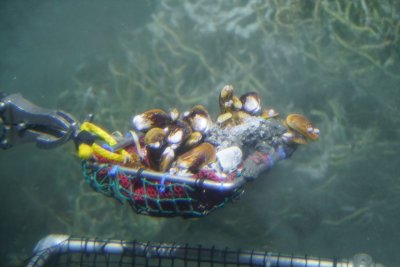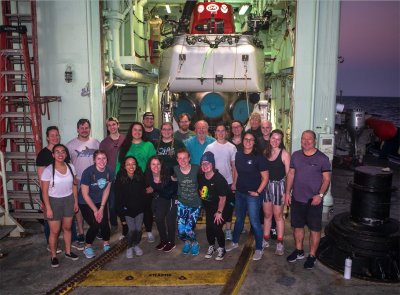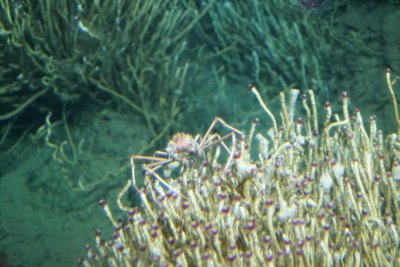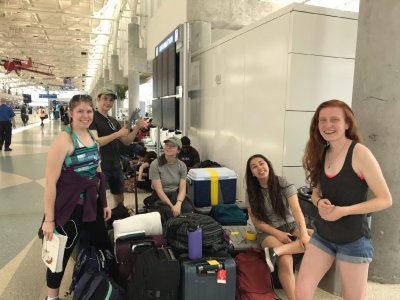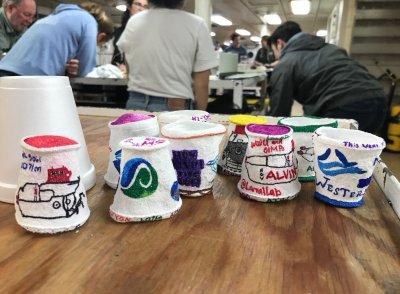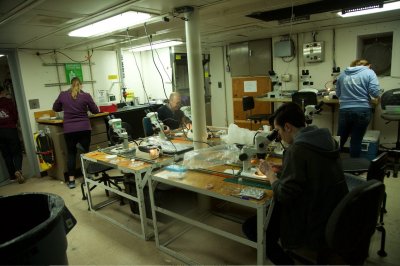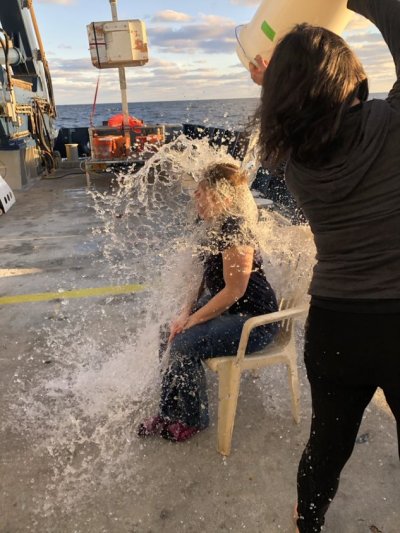Western Students Dive Deep for Answers on Gulf of Mexico Research Cruise
On board the R/V Atlantis in late February, Assistant Professor of Biology Shawn Arellano and five Western undergraduate students spent the last couple weeks of Winter quarter cruising around the Gulf of Mexico researching deep sea larvae and other marine creatures.
Two lucky undergraduates from Western also had the opportunity to go on a deep-sea dive in one of the most famous submersibles in the world, DSV Alvin.
When the group, who called themselves the Larval Lab, drove down to the Sea-Tac airport on February 22, they were tasked with transporting all of the necessary lab equipment. For some of the undergraduate students, this meant stowing away equipment in their checked luggage, and for the other students it meant carrying microscope heads onto the plane in their carry-on bag.
“It was definitely a lot, people thought we were crazy in the airports,” said Laura Anthony, a senior Biology major (now WWU alumna) from Helena, Montana. “We had these huge tubs with a bunch of scientific equipment. We took the microscope heads and wrapped them in our clothing, and then put them in our carry-ons so they wouldn’t break.”
After a day of traveling, the students finally got to Gulfport, Mississippi where they embarked on R/V Atlantis. By the time they got on board, it was quite late after a long day of travel across the country.
“At 1 or 2 a.m., we were taking these ginormous pieces of luggage up and onto this boat, and it was a struggle,” said Glenna Dyson, a senior Environmental Science major. “It was an exhausting day.”
The next day on R/V Atlantis was spent setting up the lab and sailing to their first dive site. They arrived at a site called Brine Pool NR-1 off the coast of Louisiana on Feb. 26. A brine pool is a body of brine water, or water that has a greater concentration of salt than the surrounding ocean water, that pools on the ocean floor. Alvin was in the water and ready to dive by 8 a.m. with two graduate students and a pilot on board.
The Alvin submersible is no stranger to deep-sea dives. Alvin was the submarine that explored the Titanic wreck and has went on over 1,000 dives across the world. The dives Alvin for this research cruise were more than just a tour of the Gulf’s sea floor, though. The small crew onboard placed equipment and instruments on the ocean floor to measure the local ecosystem. Alvin was also equipped with a biobox to store specimens and cameras to film the dive sites.
“We set out instruments and little collection devices that collect the larvae,” Arellano said. “We are interested where in the water column the larvae from deep-sea animals are living and dispersing. Other instruments are collecting information on currents. These instruments are set out for a year to collect data.”
Hailey Dearing, a sophomore Biology major from Snohomish, was the first lucky undergraduate student to go on an Alvin dive. Alongside two Alvin pilots who were on a training dive, Dearing went down to the brine pool at a depth of over 2,100 feet.
“I was really nervous and excited at the same time,” Dearing said. “There was a lot of pressure on me to know where to place all of the instruments.”
The Alvin pilots helped to put Dearing’s nerves at ease. Even though she had never gone deep underwater before, the pilots made it seem like what they were doing was an everyday occurrence. On the trip down, they spent the time chatting and taking turns looking out the window to catch a glimpse of bioluminescence. The dive wasn’t just for sightseeing, however.
“It was a lot of work,” Dearing said. “We spent eight hours in the sub and most of it was writing down what we saw, taking pictures, manning the cameras and video feeds, and keeping our eyes peeled because there is a lot of stuff at the sea floor that isn’t seen often.”
With the pilot’s direction, Dearing had the opportunity to drive Alvin while they were at the dive site. Because it was their second day at the brine pool, the pilots knew what Dearing and the others up at the surface were looking for.
“Every little thing I saw was interesting,” Dearing said. “Whether I was seeing a mussel for the first time or watching spider crabs moving around the mussels or seeing all of the different kinds of fish. Just seeing how the colors of the ocean floor, like white and orange, were that way because of different bacterial mats was really cool.”
Rough waters
The research cruise wasn’t all smooth sailing.
The day after the first dive, R/V Atlantis encountered some rough weather and waves, and many of the crew and group of researchers had to deal with a bad case of sea sickness. Out of all of the undergraduate students, only two managed to keep sea sickness at bay: Dexter Davis, a junior Environmental Science major from Seattle, and Esmeralda Farias, a senior Biology major from Duvall, spent most of that day in the lab looking for tiny larvae under the microscope while their fellow students were under the weather.
“All of the students were dropping like flies,” Davis said. “But we were able to spend nine or ten hours using the microscopes to search for larvae shells for Shawn.”
For many of the students, seasickness was something they battled throughout the cruise, not just on the second day. Looking through a microscope for the tiny larvae made it easy to get dizzy and feel sick, so they had to take quick breaks like a walk on the deck. If it was a bad bout of seasickness, the students would go to their room to try and sleep it off.
On March 1, Anthony was able to go down on an Alvin dive to a site called the Mississippi Canyon, located off the coast of Louisiana. Unfortunately, her dive was cut short because of bad weather but she was still able to be at the site for seven hours. Anthony said the trip down was an exciting experience because as she descended, the sunlight gradually dimmed to a pitch-black darkness. The farther down they went, she saw sudden bursts of light from bioluminescent plankton and other marine creatures.
“It was definitely a dream come true,” Anthony said. “I’m planning on going into deep-sea research, so it is great to be able to say that I went on an Alvin dive as an undergrad.”
Even though Anthony and the crew in the submarine were over 3,280 feet, or more than half a mile, below the surface, the temperature inside never got too cold or too hot. On the dives, the crew generally bring a sweatshirt just in case it gets a little chilly and they have backup blankets for another layer if needed.
The students spent most of their days running experiments, collecting larvae samples for Arellano, and helping the other graduate students on their projects. Farias said everyone worked collaboratively with each other and helped with any of the projects when they had the time, and dipping their toes into many different parts of the project just gave them an even broader research experience.
“Wherever we were needed, we were happy to help,” Farias said.
The undergraduate students were also encouraged to run their own experiments as well. Davis and Farias were able to take some of the mussel larvae samples that were collected from the dive sites to see which substrate they preferred to attach to, such as other mussel shells or the abyssal threads that mussels produce to latch on to rocks or sand.
The research cruise had graduate students and researchers from the University of Oregon and North Carolina State University and was funded in part? by a $437,398.00 grant from the National Science Foundation to Arellano. The cruise was held in two legs: one from February 24 to March 5, and one from March 5 to March 14. While on board R/V Atlantis, some of the students kept up a blog called “Dispersal of Deep-Sea Larvae” that can be read here.
The first leg of the research cruise ended with a personnel switch off the port of Fort Lauderdale, Florida. Arellano and the undergraduate students climbed down a ladder off the side of R/V Atlantis to a small boat, and their luggage was hoisted down with ropes. Tessa Beaver and Michelle McCartha, two Marine and Estuarine Program graduate students at Western from Olympia and Port Orchard respectively, climbed on board for the second leg of the cruise and headed up the Atlantic coast continuing their research dives until they reached North Carolina.
The undergraduate students said the trip was a great way to gain experience. From being on a research cruise, taking part in launching Alvin or going on deep-sea dives, and helping gather data and running experiments with the faculty members or graduate students, the trip taught them a lot.
“It’s very unique to be able conduct those kinds of experiments as an undergraduate, especially on deep-sea creatures,” Davis said. “We were one of the first to see these free-swimming mussel larvae, which just looked like a little swimming shell. It wasn’t easy, but it was well worth it and one of the most valuable experiences of my undergrad career.”
